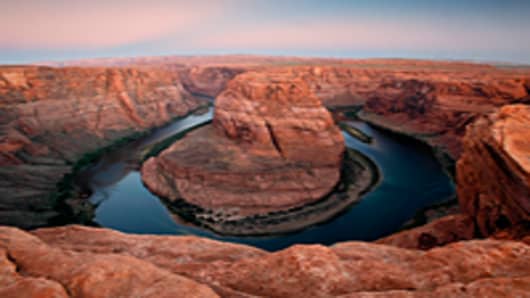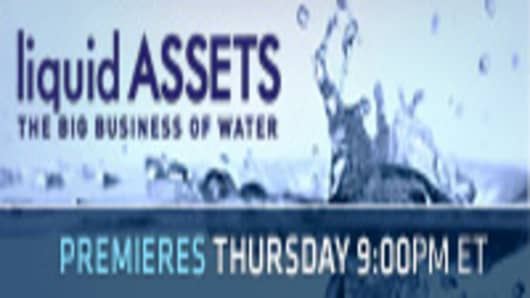Water has been an issue ever since the west was won.
Seven states rely on water from the Colorado River for their residents, farms and industries. But a boom in population and development, particularly in the Southwest, has created even higher demand for that water, and an 11 year drought has siphoned off the supply.
“Its one of the most severe droughts that we've seen in the 100 or so years of record keeping,” says Terry Fulp, deputy regional director of the Bureau of Reclamation's Lower Colorado Region. (The Bureau manages the Colorado River and much of its infrastructure, including the Hoover Dam, on behalf of the states.)
To make matters worse, the water storage basins Lake Mead and Lake Powell, which were set up to stockpile water for this kind of drought, are depleted. Together, they contain only 58 percent of the water they were designed to hold. Visitors to the Hoover Dam can easily observe “bath tub” lines around Lake Mead, showing where the water line used to be. It’s a drop of more than 130 feet.
“Am I concerned? Yes I am concerned. We are less than 15 feet away from a potential shortage condition. That’s a very real thing,” says Lorri Lee, Bureau of Reclamation Lower Colorado regional director. “We have never been in a situation in the lower basin where we've not been able to deliver the water orders that have come in from the states.”
“We have to plan now for the future. We can't wait to see how it pans out. We've got to put plans in place now so that no matter what that future trajectory ends up being, at least we've prepared for it,” Fulp says.
Thirty miles from the Hoover Dam, the city of Las Vegas is preparing for a shortage. “I know it’s a very real possibility. I know the Southwest will face it at some point, it’s just a question of when,” says Pat Mulroy, Southern Nevada Water Authority general manager.
A top priority for the city: Get citizens and businesses to cut back on their water use. This includes enlisting a police-like force of water waste investigators. They patrol the city streets looking for broken sprinkler heads and water running down the streets. That’s because in Sin City, the biggest water wasters aren’t the casinos’ iconic water features but homeowners with lawns.
“Our residents come from another part of the country where they're used to having a lot of grass and they get a lot of rainfall,” says Water Waste Investigator Raymond Guerra, “We only get four inches of rain. Last year, we only had one and a half inches of rain and so it really puts a strain on the water system.”
The water authority even pays people to remove turf.
The city’s star attractions, from golf courses to casinos, are helping the conservation efforts. The Las Vegas Sands recently installed a nano-filtration plant—part of a plan to save 166 million gallons of water each year.
Despite its population boom, these efforts have helped Las Vegas conserve one-third of its water. The city has all the encouragement its needs right in its own back yard.
“The best tool that we have found is that people need to know that there is a real need for them to conserve in a very personal way. And we've been able to point to Lake Mead and say we have to do something,” says Mulroy.
See more about the global water crisis, conservation efforts in the US and other countries, and how businesses are responding, in a CNBC Original Production, “Liquid Assets: The Big Business of Water,”Thursday September 30 at 9pm ET.



